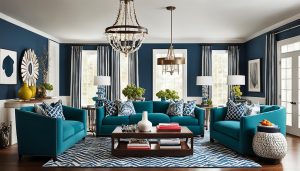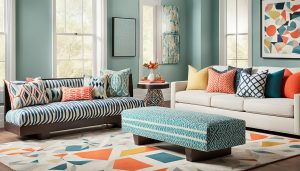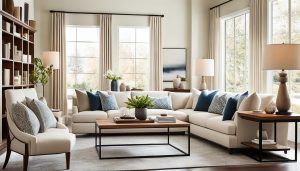We all want our homes to show who we are. Decorating is how we share our personality. Finding the right mix of styles, like old and new, is tough. That’s where mixing things up comes in handy.
Picture a living room with a mix of furniture styles. You see a mid-century chair next to a vintage sofa. A modern glass table sits in the middle. This space tells a unique story with each item.

Mixing things lets you make a look that’s all your own. Learn about different furniture styles. Then, pick the ones that fit you best.
It’s important to match colors and designs when you mix styles. Start with a color palette that works with your favorite looks. This brings everything in your space together.
Don’t forget about textures. Mixing fabrics, like velvet with leather, makes things interesting. It adds layers to your space.
Feel free to mix patterns too. Choose patterns that go well together in color and size. This adds fun and uniqueness to your home.
Thinking about what you have and what you like is key. Do this to make your space look great. Mixing and matching makes your home stylish and special.
Before you start mixing and matching furniture styles, you need to know the basics. This means getting familiar with popular furniture styles. When you understand each style, you can design a living space that looks great and feels right.
Modern furniture is known for its sleek design. It uses clean lines and modern materials like metal and glass. Choose pieces that are simple and useful but also look elegant. This approach fits well with modern styles.
Traditional furniture is about timeless beauty and classic looks. It often has rich woods and detailed designs. When picking furniture, look for pieces with fine carvings and high-quality fabrics. This will add a touch of elegance to your room.
Industrial furniture is inspired by old factories and warehouses. It often uses raw materials like steel and distressed wood. Pieces may have an unfinished, rough appearance. Add items with metal details or reclaimed wood to give your room an urban and edgy feel.
Mid-century modern furniture reflects a retro style. It has organic shapes and bold colors. When styling, go for items with sleek designs and bright colors. These elements will bring a fun and sophisticated look to your room.
Bohemian furniture is all about being free and creative. It uses lots of different textures, patterns, and colors. Mix fabrics, use bold patterns, and layer textiles to create a space that is comfy and inviting.
Knowing about these furniture styles helps you make your space look amazing. You can mix and match elements from different styles to bring your own special touch. Let your creativity lead as you design a space that shows your unique style and preferences.
Before you start mixing furniture styles, find the main style in your space. Look at the furniture you already have. Think about the design styles they show. This helps you see the overall look of your home. Also, your home’s architectural features and the colors you use can point to the main style.
First, check out your current furniture. Notice if it has clean lines, fancy details, or unique shapes. These clues can tell you the type of style. For instance, a mix of glass and metal might mean a modern look. Or, detailed woodwork could show a traditional style.
Take a moment to look at your home’s structure and design. Things like moldings and archways can give hints about the style. Elaborate moldings and big archways often signal a traditional style. But, simple, modern details suggest a more modern style.
The colors you use can also show the style. Soft colors like neutrals and pastels link to traditional or modern looks. These colors make the place feel calm and elegant. On the other hand, bright colors like blues, reds, and yellows might point to a boho or mid-century look. They bring energy and creativity.
Thinking about your furniture, architecture, and colors can show you the home’s style. With a close look at these, you’ll understand your home’s atmosphere better. This makes it easier to choose new furniture that fits well.
Creating a beautiful living space involves some important principles. When mixing furniture styles, aim for balance and symmetry. Make sure colors match and think about size and proportion. Following these guidelines helps make your design look well put together.
Balance is key in making a space feel right. It means arranging things so nothing feels too heavy or light. You might place items the same on both sides for symmetry. Or mix things up with asymmetry, like pairing a big sofa with smaller chairs.
Picking the right colors is crucial for a unified look. Choose a color scheme that works with your furniture styles. This could be by picking colors that go well together, or even just sticking to one color. The goal is for everything to harmonize and look good together.
Scale and proportion are big considerations in mix and matching. Scale looks at how furniture fits the space. It’s vital to ensure everything feels in its place. Proportion is about the relationship between your pieces. They should all agree in terms of size and shape.
| Principle | Description |
|---|---|
| Balance | Achieve equilibrium by evenly distributing visual weight in the room, either through symmetrical or asymmetrical arrangements. |
| Color Coordination | Select a color palette that complements different furniture styles, ensuring a harmonious blend of colors. |
| Scale | Choose furniture that fits the room appropriately, considering its size in relation to the space available. |
| Proportion | Maintain a balanced relationship between different furniture pieces in terms of size and shape, ensuring they work harmoniously together. |
Using these key ideas can make your living space feel just right. It’s about creating a look that’s uniquely yours, while keeping everything in harmony.

Creating a unified look in your living space is essential. It’s all about using common elements wisely. This technique helps blend different furniture styles together well. You can do this by repeating certain materials, shapes, and colors.
For instance, using similar wood detailing can connect a wooden table with metal chairs. This connection complements both styles. You can also use common shapes or images to keep things flowing. Pairing round mirrors with a contemporarily styled coffee table can establish harmony and balance.
Choose common elements thoughtfully to mix different furniture styles beautifully. This makes your space feel like everything belongs together. Stick to the same materials, shapes, and colors. This brings your styles into perfect harmony.
Finding the right balance is key to a stunning design that mirrors who you are. Mixing different styles is exciting. Let shared elements unite them in a way that’s truly captivating.
Transitional furniture is key in making your home’s style work together. It blends different styles well, making your space look put together and attractive.
It is made to fit many looks, so it’s great for mixing styles. This furniture can match both old and new, classic and hip designs without clashing.
Transitional pieces usually come in neutral colors. These colors, like white, grey, and beige, fit with lots of different styles. They help your space look well-designed no matter the color scheme.
They also often use timeless designs. You might see clean sofas or elegant tables. These shapes add a touch of class to any room, balancing the look.

Adding transitional furniture can make your space flow better. It works with many styles, helping you achieve a design that feels complete.
To have a space that’s uniquely yours, you need to blend the old with the new. With transitional pieces, you can style your home your way, keeping it all looking good together.
Consistency is very important in home design. Using the same flooring material in main areas like the living room, dining room, and hallway creates a flow. It makes the space look unified.
But, not every room has to be the same. You can mix it up in places like the bathroom or kitchen for a personal touch. This keeps the sense of unity while adding variety.
Keeping the wood stain color and trim consistent is key too. Matching colors in the trim and wood creates a harmonious background. This ties your furniture and design together into one polished look.
Using the same flooring and trim makes your home easier to clean. You won’t need to use different cleaners for each room’s floor. It also helps rooms flow into one another smoothly.
Focus on the same flooring and trim to make your home more beautiful. This approach makes your space relaxing and welcoming. It improves both the look and feel of your house.
A good color palette is vital for a unified design. Choose colors that fit your design style well. This includes modern, traditional, industrial, mid-century modern, or bohemian looks. Your chosen colors should make the space look and feel better. Use different colors in each room to make things more interesting and deep.
It’s important to keep your color scheme consistent. Each room can have its own colors, but they should all work together well. This helps create a smooth flow between spaces. Pick a few key colors and use them in various ways. You could use different shades of a color in artwork or throw pillows to tie everything together.
Accent lighting also plays a big part in your color palette. Place accent lights strategically to highlight the room’s best features. Good lighting can enhance your colors. It makes them look brighter and creates a cozy space.
| Design Style | Color Palette |
|---|---|
| Modern | Neutral tones with pops of bold colors like red or blue |
| Traditional | Earth tones like brown, beige, and green with warm accents |
| Industrial | Neutral tones with gray, black, and metallic accents |
| Mid-century modern | Muted pastels, bold retro colors like orange or teal |
| Bohemian | Rich jewel tones, vibrant patterns, and earthy hues |
Remember, your color palette is your personal choice. It should reflect your style and likes. Try out different colors, textures, and accents to see what works for you. A curated palette not only makes a beautiful space but it also brings consistency and harmony to your home.
Creating an engaging living space means mixing different textures. You can use paint, tile, rugs, furniture, and art to make your home stand out. Each choice adds its own uniqueness and style.
Textures are key for making your home feel deep and interesting. Try a textured wallpaper or wall to draw eyes. Or, add luxury with textures like a chunky knit throw or a velvet cushion.
Rugs are a great place to start with textures. They offer comfort and style, bringing your design together. Pick rugs with different materials and designs for a visually rich space.
“Using rugs can help make your flooring more individualized in each room, adding a unique flair to the space.”
For a unified look, mix different fabric textures in your furniture. Combine a leather sofa with a woolen armchair for contrast. Mixing upholstery textures brings balance and depth to your space.
To get a beautiful look, mix not just textures but also patterns. It can really lift your room’s feel, making it vibrant. Choose one big pattern and mix in smaller ones for a beautiful look.
Remember: When mixing patterns, pick ones that share a color. This creates harmony and a unified look.
Choose and mix patterns carefully to make your space uniquely yours.
Adding textures and rugs is a great way to give your home its own style. Whether you’re playing with fabrics or patterns, let your personal style shine through. Create a space that shows who you are and what you love.
Making your home’s design work well together is key for a beautiful look and feel. Choose colors wisely, use similar pieces, and mix items that go well together. This creates harmony and shows off your unique style.
Start with picking colors that fit your style. It makes everything feel connected and inviting. Use the same materials or colors in different ways. This links your furniture, making everything look complete.
Try mixing soft and bold textures to make your design intriguing. Play with fabric types, like plush velvet or airy linen. Doing this brings a room to life. Mixing furniture styles can also be fun and lets your personality shine.
Balance is important in a well-designed home. Stick to what you love. This will keep your space looking and feeling great. Following these tips helps you build a home that’s both beautiful and personal.
Yes, it’s a great idea to mix different furniture styles. This approach can make your living space look put together. Start by figuring out what styles you like best. This will help you keep things consistent and unique.
There’s a lot you can play with. Think about modern, traditional, industrial, mid-century modern, and bohemian looks. Each style brings different elements and vibes to a room.
Look at what you already have. Your furniture and its design tell a story. Also, think about your home’s features and the colors you’ve used. These elements shape the style of your space too.
Mixing styles requires some thought. Think about balance, symmetry, and how colors play off each other. Also, make sure everything fits the size of your room. Following these principles will make your mix of furniture look great.
Make everything feel connected by using similar shapes or colors. When you repeat these elements, your styles will blend well. This approach helps create a consistent and unified appearance in your home.
Transitional furniture is key for blending different looks. These pieces can easily fit in with various styles. Opt for them in neutral colors and classic shapes. This makes them versatile and helps keep all your furniture in harmony.
Keep your flooring the same in open areas. You can change this in specific rooms while still connecting to the main look. Also, try to match the wood stain of your trim throughout. This keeps your design tied together.
Pick a color scheme that fits your overall style. You can spread these colors differently in each room for a fresh feel. Add accent lighting to bring out these colors. This will help your home feel consistent and pulled together.
Use textures in your choice of paint, tile, rugs, and more. This adds depth to your design. Rugs, especially, are great for making each room stand out. They add a personal touch to your space.
A cohesive design makes your home look and feel whole. With the right color palette, shared elements, and careful mixing of furniture, you can create a space that’s both stylish and harmonious.